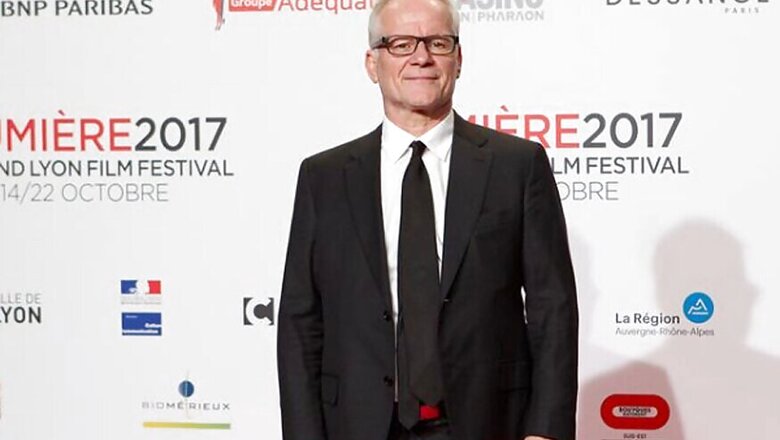
views
Tokyo: One of the highlights of the ongoing Tokyo International Film Festival was the Lumiere show. A magical compilation of 98 shorts made by two French brothers, Auguste and Louis, was screened on October 26.
The brothers are credited with discovering what we today call cinema or what the Americans once termed motion pictures. In fact, the Lumiere Brothers, for the first time, infused still pictures with life in the Paris of 1895.
In what seemed like a spectacular 4K compilation of digitally restored works which Auguste and Louis made between 1895 and 1905 was presented in Tokyo by no less a celebrity than the Cannes Film Festival supremo, Thierry Fremaux.
Fremaux wears two hats -- as the chief of the world's premiere festival at Cannes and as the head of the Institut Lumiere at Lyon. According to him “the showcase enables us to rediscover and celebrate Auguste and Louis Lumiere, moviemakers who are responsible for film as we know it, whose pioneering moving snapshots of life at the end of the 19th century (and the start of the 20th century) paved the way for the popularisation of the medium and its evolution into an art form.”.
In 1895, the Lumiere Brothers invented the Cinematograph (a device for capturing, developing and projecting movies) and went on to film some of the first moving images in the history of cinema. Some of them screened in Tokyo show factory workers emerging from work, a steam engine and people scaling a snow-covered mountain. Some of these are celebrated masterpieces, others lesser known gems. They give us a glimpse of France and the world as they looked once upon a time.
The French have always known to be masters of preservation, and, it comes as no surprise that the Lumiere cinema has been conserved. What is more, the Brothers’ house in Lyon (France) is now a beautifully preserved museum.
(India too had its movie pioneers like Dadasaheb Phalke and Hiralal Sen among others. There are no memorials or museums for them, if one is right. A proper museum for the legendary Satyajit Ray -- who actually introduced Indian cinema to the world on the Cannes platform -- is still being talked about -- although a part of his house in Kolkata is now being seen as a memorial to the master).
In 1895, two Lyonnais brothers, Louis and Auguste Lumiere, were running a photographic plate manufacturing business with their father, Antoine, and decided to test out the prototype of a new movie camera they were developing. They took their Cinematograph, planted it in front of their factory and filmed workers as they left at noon. And the rest is history.
The Lumiere Brothers are now credited as the fathers of cinema, and their 50-second Workers Leaving the Lumiere Factory is considered to be the first true motion picture. They would go on to train cameramen, and a few years later, sent them all over the world, including Japan. The men documented an amazing variety of cultures and scenes in the early years of the 19th century.
About 120 years later, Fremaux is honouring the Lumiere legacy by restoring and presenting the brothers' work.
The shorts are all silent, of course, but Fremaux's delightful tribute includes an expressive musical score by the French composer, Camille Saint-Saens, and a spirited commentary narrated by the Cannes chief himself. Shiraku Tatekawa, famous for his television talk shows on gourmet cooking, gives the Japanese version of the commentary.
Fremaux said during the Asian premiere of his Lumiere compilation on October 26: “There are three ways to watch a silent film: silent silent, silent with music, and silent with commentary. The commentary I made is a way to bring you into this world. I love it when someone explains to me a Beethoven symphony or a Picasso painting or a Mark Rothko abstract, and I thought it was necessary for the audience to know something about what these movies were. I chose Saint-Saens because he was a contemporary of the Lumiere Brothers, and the music fits the time period.”
Shiraku, attired in an elegant kimono, joined Fremaux on stage and admitted: “I had never done a narration for film, although I’ve been doing commentary on television. I’ve also been writing my column for 20 years in [cinema magazine] Kinema Jumpo, so I knew the name Lumiere, but I didn’t know their work. The Japanese usually associate Thomas Edison with the birth of the movie. I didn’t imagine it could be interesting, but when I saw the footage, I was blown away. I was engrossed for 90 minutes.”
In a friendly retort, Fremaux joked that “technically, Edison could have invented cinema, but instead he invented a small box, the Kinetoscope, where just one person could pay to see the image. And that’s still the American way. But Lumiere chose to take the image and put it on the big screen and project it in front of a crowd. So Edison invented this (he held up his smart phone), but we still love going to cinemas.”
Fremaux acknowledged that “even in France, these movies were not really known and we had to teach people about them. I feel like I’m on the same path as the Lumiere cinematographer who came to Japan 122 years ago. Because cinema was a big adventure, and Lumiere sent out cinematographers to bring the world back to us. Today it’s the same adventure to take Lumiere back to the world, to tell audiences everywhere that cinema was invented in Lyon, France.”
The compilation titled Lumiere! proves, for the first time ever, that Louis who operated the camera, and his brother, Auguste, who often acted in front of it, were actually the first creators of mise-en-scène. Their films were not randomly shot scenes, as has been commonly believed.
The movies provides ample evidence that the brothers paid minute attention to staging, framing, lighting and camera movement. Mounting cameras on elevators, trains and boats, they captured a viewpoint that no one had ever seen. Beginning with films shot in Lyon, but later incorporating sequences from Paris, England, America, Martinique, Turkey, Spain, Tunis and beyond, the style of Lumiere cinema varies from ethnographic documentary to staged comic sketch and even to what could be the first-ever on-screen stunt, involving a man being run over by an automobile.
Indeed, a great piece of cinematic history has been restored and preserved for posterity.




















Comments
0 comment